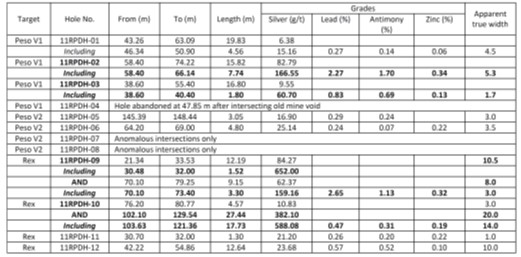Overview
The Rex-Peso Zone lies approximately 4 kilometres west of the Eagle Gold Mine and is part of the southwestern extension of the Potato Hills Trend mineralized belt. The Rex-Peso zone is made up of two main polymetallic vein systems, the Rex vein system, and the Peso vein system, which trend west and dip moderately to steeply north. These vein systems were extensively explored by Peso Silver Mines Ltd from 1961 to 1965, including underground development on the Peso No 1 vein and the Rex vein amounting to approximately 1,067 metres of drifting, shaft sinking and adits to approximately 90 metres below surface. Results of this work outlined a historical mineral reserve (not NI 43-101 compliant) of 154,000 tons grading approximately 20 oz/ton silver and 3.7% lead. These vein systems have been traced along the surface for over a kilometer by historical trenching and display a similar mineralogical signature and structural setting to the polymetallic veins seen in the Keno silver district, located 30 kilometres to the east-southeast. Common minerals include argentiferous galena, sphalerite, arsenopyrite, pyrite, jamesonite and other sulfosalts.
In 1991, M J Moreau Enterprises Ltd reported results from rock samples in the same area that returned up to 1.7 g/t gold and 37.8 oz/ton silver. In 2011, Victoria reported further rock sample results in their press release dated August 16th, in which three rock chip samples returned silver values between 1,060 and 6,410 g/t.
In 2011, a first phase reconnaissance exploratory program of 12 diamond drill holes was completed for a total of 1,428 meters, targeted on vein systems which have remained essentially unexplored since the 1960s. The 2011 program confirmed the presence of thick, high-grade silver intervals, with best results of 4.81 m of 259 g/t Ag and 0.93 m of 0.45 g/t Au and > 10,000 g/t Ag. Also of significant interest at Rex-Peso is the gold mineralization potential proximal to Cretaceous age intrusive dykes as well as carried in the silver vein-faults. Several operating current and past placer gold producers (e.g. Secret Creek) have their headwaters in the Rex-Peso area, and stream sediment samples returned anomalous gold throughout Secret Creek, Gil Gulch and 15 Pup. A series of outcropping dykes are observed in the area, however airborne geophysics suggests the presence of a much larger buried intrusion which may be feeding the system.
In 2017, the exploration program consisted of a 50m x 50m spaced soil grid over the main Rex intrusion followed by a ground IP, Mag and VLF survey. 19 diamond drill holes for 3,300m and 23 trenches for 1,514m were subsequently completed over the Rex ridge area following up anomalous gold and arsenic in soil results as well as historically traced faults.
In 2021, A drilling program consisting of 19 diamond drill holes totaling 3,447.3 m was conducted on the Rex vein system testing for continued mineralization above and below the historical underground workings.

